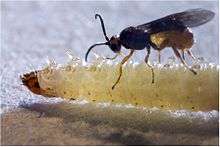Braconinae
| Braconinae | |
|---|---|
 | |
| Bracon brevicornis, female inserting ovipositor into paralyzed host. | |
| Scientific classification | |
| Kingdom: | Animalia |
| Phylum: | Arthropoda |
| Class: | Insecta |
| Order: | Hymenoptera |
| Family: | Braconidae |
| Subfamily: | Braconinae |
| Tribes | |
|
See text | |
| Synonyms | |
| |
The Braconinae are a large subfamily of braconid parasitoid wasps with more than 2,000 described species.[2] Many species, including Bracon brevicornis, have been used in biocontrol programs.
Description and distribution
Braconines are small to medium sized wasps. Many are dark in color, but they can be red, orange, or pale. They have cyclostome mouthparts and females usually have a long ovipositor.
They are found worldwide, but are most diverse in the Paleotropical region.
Biology
Braconines are idiobiont ectoparasitoids of concealed larvae. The hosts of most species are Lepidoptera or Coleoptera, with a few attacking Diptera or Symphyta. Usually, they paralyze the host with venom before laying one or more (depending on the species) large eggs on the host's exterior.[2]
Tribes
- Adeshini
- Aphrastobraconini
- Argamaniini
- Bathyaulacini
- Braconini
- Coeloidini
- Euurobraconini
- Glyptomorphini
- Gnathobraconini
- Physaraiini
- Rhammurini
- Vaepellini
References
- ↑ Ichneumonoids Adsciti. CGD Nees von Esenbeck Genera et Familias Divisi, Magazin Gesellschaft Naturforschender Freunde zu Berlin 5, 3-37, 1811.
- 1 2 Wharton, Robert A.; Marsh, Paul M.; Sharkey, Michael J. (1997). Manual of the New World Genera of the Family Braconidae (Hymenoptera) (PDF). Washington DC: The International Society of Hymenopterists.
External links


- Braconinae at the Encyclopedia of Life
- Photos at BugGuide.net
- DNA barcodes at BOLD Systems